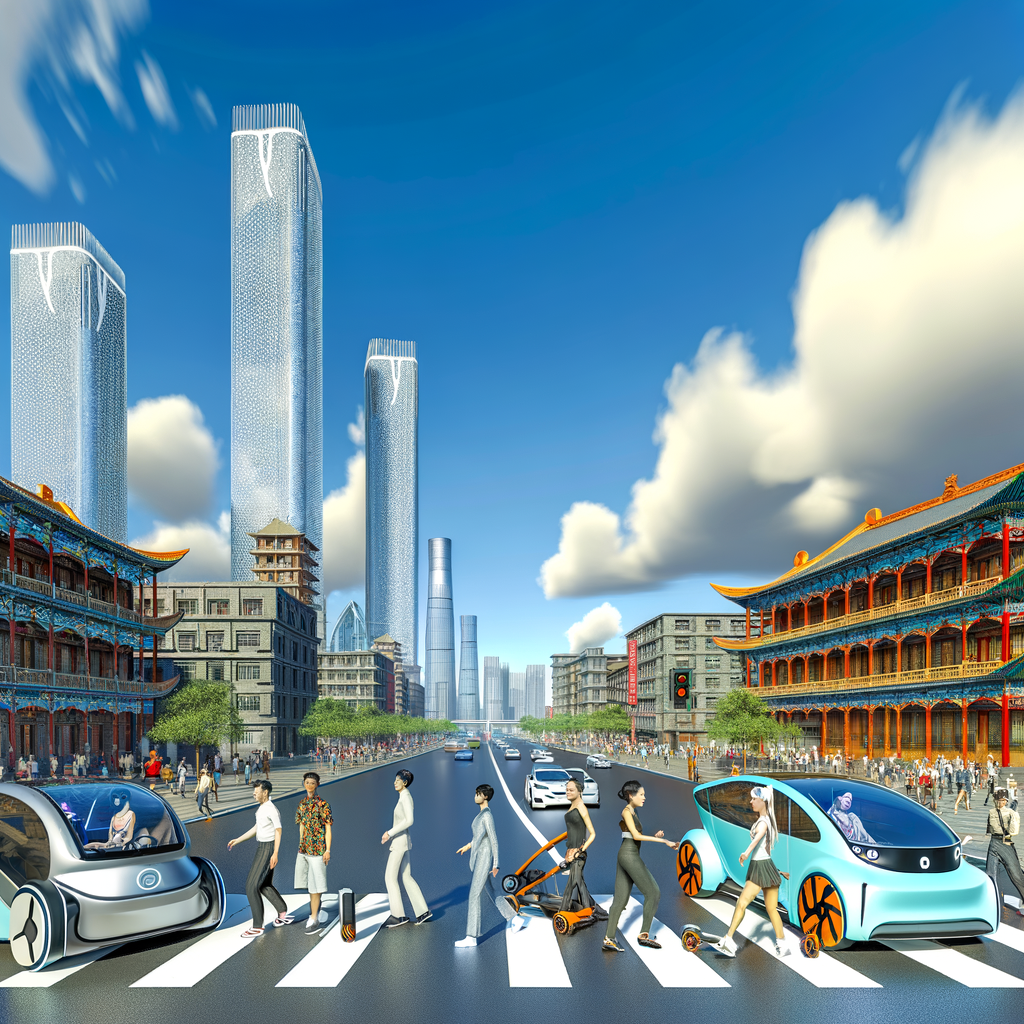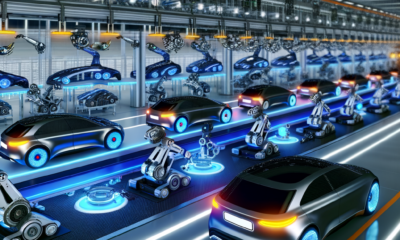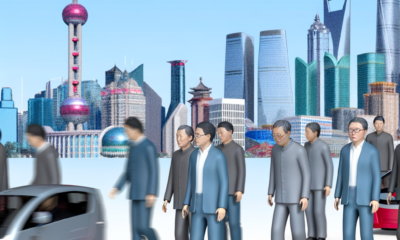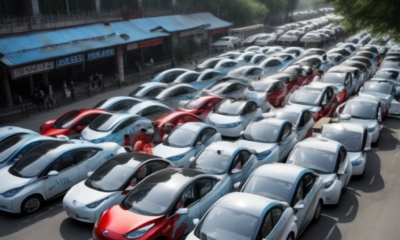China
Driving the Future: Navigating China’s Largest Automotive Market with EVs, Joint Ventures, and Strategic Innovation

In the world's top Largest Automotive Market, China, foreign automakers are increasingly engaging in joint ventures and strategic partnerships with domestic car brands to tap into the booming demand for Electric Vehicles (EVs) and New Energy Vehicles (NEVs). This shift is driven by a combination of environmental concerns, government incentives, rapid urbanization, and a growing economy, reshaping consumer preferences towards sustainable transportation solutions. These collaborations are crucial for navigating China's complex regulatory landscape, leveraging technological advancements, and staying competitive in a market characterized by intense competition. Strategic partnerships are not only key for market entry but also essential for aligning with the evolving demand for EVs and NEVs, positioning China as a leader in the global transition to cleaner vehicles.
In the heart of the global automotive industry, the China automotive market stands as the world's largest, propelled by a top-tier status in both production and sales. This vibrant market is the epicenter of a rapidly growing economy, burgeoning middle class, and a wave of urbanization, making it a magnet for both domestic car brands and foreign automakers alike. With a keen eye on the future, China is steering towards a green horizon, emphasizing Electric Vehicles (EVs) and New Energy Vehicles (NEVs), fueled by significant government incentives and mounting environmental concerns. The landscape is highly competitive and dynamic, shaped by a complex regulatory framework that foreign players navigate through joint ventures and strategic partnerships with local Chinese companies.
This article delves into the intricacies of thriving within the world's Largest Automotive Market, exploring the crucial role of Joint Ventures and how strategic partnerships are a linchpin for success amidst stiff market competition and a challenging regulatory landscape. We further electrify our narrative by examining the surge of EVs and NEVs, a trend that positions China as a global leader in the automotive sector's future. This surge is not just a testament to technological advancements but a reflection of evolving Consumer Preferences, driven by Government Incentives and a collective push towards mitigating environmental concerns.
Understanding the China automotive market is a journey through a terrain shaped by Government Policies, Consumer Preferences, Technological Advancements, and Global Economic Trends. It's a story of adaptation, innovation, and strategic foresight, where Domestic Car Brands and Foreign Automakers alike vie for dominance in an economy marked by Urbanization and an ever-Growing Economy. Join us as we navigate the complexities of this lucrative but challenging environment, offering insights into the pathways carved by strategic partnerships and the electrifying pace set by the adoption of EVs and NEVs.
- 1. "Navigating the Terrain: How Joint Ventures and Strategic Partnerships Power Success in China's Largest Automotive Market"
- 2. "Electrifying the Dragon: The Surge of Electric Vehicles (EVs) and New Energy Vehicles (NEVs) in the Heart of the World's Top Car Market"
1. "Navigating the Terrain: How Joint Ventures and Strategic Partnerships Power Success in China's Largest Automotive Market"

In the heart of the world's Largest Automotive Market, foreign automakers are leveraging joint ventures and strategic partnerships as essential navigational tools to tap into China's booming automotive industry. With China's growing economy fueling a surge in urbanization and a burgeoning middle class, the demand for both domestic car brands and international models has skyrocketed. However, the allure of this vast consumer base comes with its challenges, notably a complex regulatory landscape that requires astute navigation to ensure compliance and success.
Joint ventures have emerged as a popular strategy for foreign automakers aiming to penetrate the Chinese market. By partnering with local Chinese companies, foreign entities can gain invaluable insights into consumer preferences, which vary significantly across different regions of the country. This understanding is crucial in a market that places a high emphasis on Electric Vehicles (EVs) and New Energy Vehicles (NEVs), driven by strong government incentives and mounting environmental concerns. These partnerships enable foreign automakers to align their offerings with the market's demand for sustainable and innovative transportation solutions, thereby enhancing their competitiveness.
Technological advancements play a pivotal role in shaping the landscape of the Chinese automotive market. Strategic partnerships extend beyond mere market entry—they are vital for sharing technological expertise and resources. This collaborative approach accelerates the development and deployment of cutting-edge technologies in EVs and NEVs, meeting the market's appetite for high-tech vehicles. Furthermore, these alliances help foreign companies comply with China's stringent emissions standards and environmental policies, which are central to the government's push for cleaner, more sustainable modes of transport.
Government incentives for EVs and NEVs have not only encouraged consumer adoption but have also spurred intense market competition. In this highly competitive environment, strategic partnerships are more than a market entry strategy—they are a crucial element for survival and growth. Collaborating with local partners allows foreign automakers to benefit from established distribution networks, local market expertise, and favorable governmental relationships, providing a competitive edge that is hard to achieve independently.
Moreover, the success of these joint ventures and strategic partnerships is significantly influenced by an intricate understanding of the regulatory landscape. Navigating this landscape requires a delicate balance between leveraging local expertise through partnerships and maintaining brand integrity and core values. The dynamic nature of China's policies and regulations necessitates a flexible and responsive approach, where foreign automakers and their local partners work hand in hand to adapt to policy shifts and consumer trends.
In conclusion, the path to success in China's Largest Automotive Market lies in the power of joint ventures and strategic partnerships. These alliances are critical for foreign automakers to navigate the regulatory landscape, align with consumer preferences, harness technological advancements, and capitalize on government incentives. As the market continues to evolve, driven by environmental concerns, a growing economy, and rapid urbanization, the role of strategic partnerships remains central to unlocking the potential of this lucrative but challenging landscape.
2. "Electrifying the Dragon: The Surge of Electric Vehicles (EVs) and New Energy Vehicles (NEVs) in the Heart of the World's Top Car Market"

In the heart of the world's largest automotive market, a significant transformation is underway, propelled by the surging popularity of Electric Vehicles (EVs) and New Energy Vehicles (NEVs). This shift is not only reshaping consumer preferences but also redefining the competitive dynamics of the industry. As China continues to experience rapid urbanization and a growing economy, the demand for sustainable and environmentally friendly transportation solutions is becoming increasingly paramount. This trend is largely driven by the Chinese government's commitment to combat environmental concerns, leading to substantial government incentives aimed at both manufacturers and consumers of EVs and NEVs.
The strategic importance of EVs and NEVs in China cannot be overstated. With the country positioned as the top automotive market globally, the push towards electrification is seen as a critical move to maintain this status while addressing urban pollution and energy sustainability. These vehicles have become emblematic of the technological advancements sweeping through the automotive sector, fueled by both domestic car brands and foreign automakers. The latter often enter the market through joint ventures with local companies, a strategic partnership model that helps navigate the complex regulatory landscape of China's automotive industry.
Foreign automakers, in particular, have been keen to tap into the lucrative EV and NEV segments, drawn by the vast consumer base and the attractive government incentives on offer. These incentives are part of a broader strategy by the Chinese government to position the country as a leader in the global shift towards cleaner and more sustainable vehicles. As a result, market competition is intensifying, with both domestic and international players vying for dominance in this rapidly growing sector.
Consumer preferences in China are increasingly leaning towards EVs and NEVs, thanks in part to the government's aggressive push for cleaner energy usage and its substantial investment in charging infrastructure. This, coupled with the growing environmental awareness among the Chinese populace, has made electric and new energy vehicles a preferred choice for many.
The surge in EVs and NEVs is also a reflection of China's broader ambitions on the global stage. By leading in the production and adoption of these vehicles, China is not only addressing its domestic environmental and economic challenges but also positioning itself as a pivotal player in the future of global mobility. This ambition is supported by strategic partnerships between domestic giants and foreign players, leveraging the best of global technological advancements and local market insights.
In conclusion, the electrification of China's automotive market through the rise of EVs and NEVs encapsulates the country's larger goals: to sustain its position as the largest automotive market, to innovate within the sector through technological advancements, and to address critical environmental concerns. As this trend continues, the global automotive landscape will undoubtedly feel the ripple effects of China's shift towards a greener, more sustainable automotive future.
In conclusion, the landscape of the world’s top automotive market is both vast and intricate, shaped by the forces of a growing economy, urbanization, and a shift towards sustainability. China's position as the largest automotive market is not just a testament to its sheer size but also to its dynamic nature, fueled by a mix of domestic prowess and international collaboration. The drive towards Electric Vehicles (EVs) and New Energy Vehicles (NEVs) is emblematic of the market's responsiveness to environmental concerns and technological advancements, supported by robust government incentives. This, coupled with the growing consumer preferences for both domestic car brands and foreign automakers, illustrates a market that is as diverse as it is competitive.
Joint ventures and strategic partnerships have emerged as key navigational tools for foreign automakers aiming to penetrate this lucrative market, allowing them to tap into the vast consumer base while adhering to the complex regulatory landscape. These alliances are essential, not just for market entry but for thriving in an environment where technological advancements and government policies play a significant role in shaping market trends.
As we look towards the future, it's clear that understanding the nuances of consumer preferences, staying ahead of technological trends, and navigating the regulatory landscape through strategic partnerships will be crucial for success in China's automotive market. The emphasis on Electric Vehicles (EVs), New Energy Vehicles (NEVs), and the continuous growth of the middle class present both challenges and opportunities for domestic and foreign players alike. The market's competitive nature, driven by innovation and government incentives, ensures that only those who are truly adaptable and forward-thinking will thrive.
In essence, the China automotive market embodies the intersection of tradition and innovation—a place where the future of mobility is being shaped by a blend of market competition, strategic partnerships, and a relentless pursuit towards a greener, more sustainable automotive future. As the largest automotive market in the world continues to evolve, so too will the strategies of those looking to succeed within its borders.
Discover more from Automobilnews News - The first AI News Portal world wide
Subscribe to get the latest posts sent to your email.












































































